Grottes de Cougnac
Useful Information
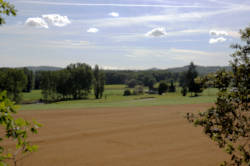


| Location: | Nera Payrignac, Département Lot. |
| Open: |
06-APR to 10-JUL Mon-Fri, Sun 10-11:30, 14:30-17. 11-JUL to 25-AUG daily 10-18. 26-AUG to SEP on-Fri, Sun 10-11:30, 14:30-17. OCT to Autumn School Holidays Mon-Sat 14-16. [2025] |
| Fee: |
Adults EUR 11.50, Children (5-12) EUR 7.50, Children (0-4) free, Reduced EUR 10.50. Groups (20+): Adults EUR 9.50, Children (5-11) EUR 7. [2025] |
| Classification: |
 Karst Cave Karst Cave
 Straw Straw
|
| Light: |
 Incandescent Incandescent
|
| Dimension: | D=90 m. T=12 °C. |
| Guided tours: | D=60 min, Max=25. |
| Photography: | Photography allowed in first cave, forbidden in second cave. |
| Accessibility: | yes |
| Bibliography: |
Méroc, Mazet (1953):
Les peintures de la grotte de Cougnac (Lot),
L’Anthropologie, p. 490
F. Koby ed. (1956): Une représentation de Tahr (Hemitragus) à Cougnac?, Bulletin de la Société préhistorique française 1956, tome 53, N. 1-2. pp. 103-107. Michel Lorblanchet (1993): Payrignac, grotte de Cougnac, datations de pigments pariétaux au radiocarbone, Bilan scientifique 1992 (SRA DRAC Midi-Pyrénées), p.99-100. Michel Lorblanchet (2004): Cougnac, Les grottes magiques, Editions Grottes de Cougnac, réédition 2004. |
| Address: |
Grottes de Cougnac, 46300 Payrignac. Tel: +33-565-414754.
E-mail: |
| As far as we know this information was accurate when it was published (see years in brackets), but may have changed since then. Please check rates and details directly with the companies in question if you need more recent info. |
|
History
| ~1900 | first cave discovered. |
| 1949 | opened to the public. |
| 1952 | second cave discovered. |
| 1954 | declared a Monument Historique. |
| 1990 | samples taken by Michel Lorblanchet and Hélène Valladas from black paintings. |
| 1992 | samples dated by Hélène Valladas and her team at the CNRS laboratory in Gif sur Yvette. |
Description

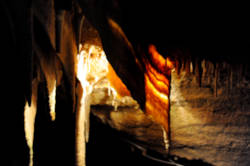
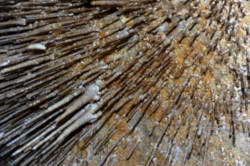

The Grottes de Cougnac are actually two caves, so the plural is in this case fitting. The two caves are about 200 m apart. The first cave is a karst cave with nice speleothems, noted for its soda straws. The tour starts with a visit of this cave. At the end of the cave is a blocked passage, which is actually the connection to the painted cave nearby. But the debris has never been removed. The passage has obviously already been blocked when ancient man visited the cave, because this part of the cave did not show any traces of man when it was discovered. As the cave ends here, the group returns to the entrance to walk to the second part of the cave on the surface.
The oldest remains in the prehistoric cave are 50,000 years old Neanderthal remains. The cave was also visited by Cro-Magnon around 25,000 and then again around 14,000 years BP. At their time the cave was entered through a crawl which was about one meter wide and 70 cm high. They left 60 images of animals, 50 outlines of hands, and three images of humans on the walls of the cave. The most important pictures are the rare paintings of ibex and tahr. The figures were painted with local red ochre.
Tahrs are wild goats, three species still exist in the Himalaya. So probably tahrs lived during the Pleistocene in France, probably they are the ancestors of our modern goats. The paintings at Cougnac are extremely rae, and other remains of goats exist but are also rare. Goat remains from the Moustérien have been found in a cave nearby.
There is another important historic fact about the Grottes de Cougnac: this was the site for the first direct radiocarbon date for Ice Age cave art. It was made by Michel Lorblanchet and Hélène Valladas who took sample in 1990 and 1992. One sample was from a black charcoal dot located near the last mammoths on the right-hand end of the main frieze. The dating in 1992 gave an age of 23,000 and 25,000 years BP for the Megaloceros panel, and 14,000 years BP for some dots. It was carried out by Hélène Valladas and her team at the CNRS laboratory in Gif sur Yvette near Paris.
The caves are located in a hill called Les Chênes Verts, with a house on top. There was a rock shelter below the house, and the place was used as a cellar by the owners. However, the crawl to the cave was blocked for 10,000 years. The entrance is today a nondescript wooden door in a historic limestone wall, which is obviously the cellar door. The second cave was rediscovered in 1952 by Lucien Gouloumes, René Borne, Jean Mazet, Roger Boudet, Maurice Boudet, and Alphonse Sauvant. This was a group of workers who tried to build a well for the house above, after a drought. Sometimes the story is told that the cave was actually discovered by a dowser. From the parking lot at the foot of the hill a paved road leads uphill to the cave entrance building with ticket office. It also offers a view on the surroundings.


Public Domain.
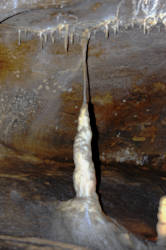
Public Domain.
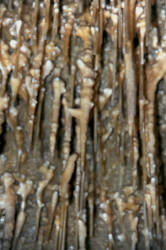
Public Domain.

Public Domain.
- See also
 Search DuckDuckGo for "Grottes de Cougnac"
Search DuckDuckGo for "Grottes de Cougnac" Google Earth Placemark
Google Earth Placemark Grottes de Cougnac - Wikipédia (visited: 07-MAR-2011) (
Grottes de Cougnac - Wikipédia (visited: 07-MAR-2011) ( )
) Les Grottes préhistoriques de Cougnac, official website
Les Grottes préhistoriques de Cougnac, official website  (visited: 01-JUL-2025)
(visited: 01-JUL-2025) Grotte de Cougnac - Cave or Rock Shelter in France in Midi:Lot (46) (visited: 01-JUL-2025)
Grotte de Cougnac - Cave or Rock Shelter in France in Midi:Lot (46) (visited: 01-JUL-2025) Cougnac Caves - Grottes de Cougnac - Dons Maps (visited: 01-JUL-2025)
Cougnac Caves - Grottes de Cougnac - Dons Maps (visited: 01-JUL-2025) Grotte de Cougnac (visited: 01-JUL-2025)
Grotte de Cougnac (visited: 01-JUL-2025)
 Index
Index Topics
Topics Hierarchical
Hierarchical Countries
Countries Maps
Maps